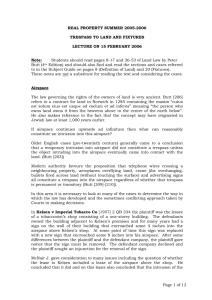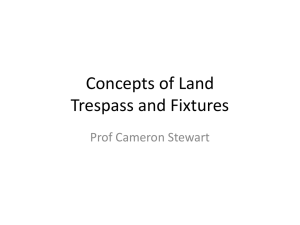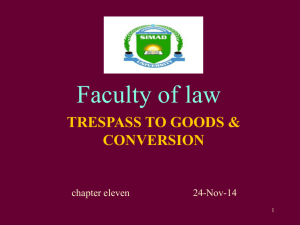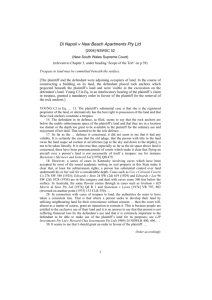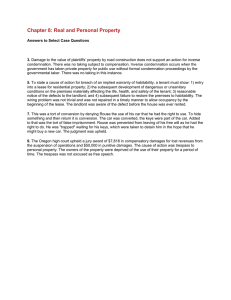Concepts of Land Trespass and Fixtures
advertisement
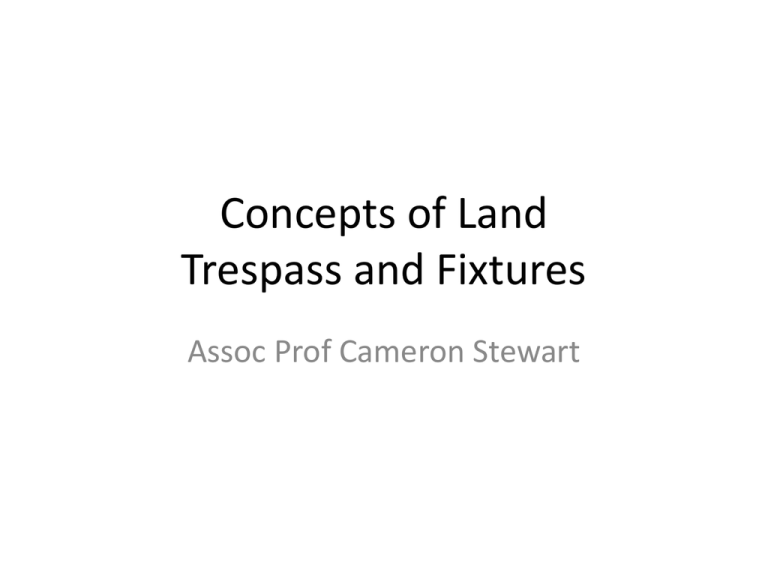
Concepts of Land Trespass and Fixtures Assoc Prof Cameron Stewart What is land? • Land is a three dimensional space referable to a point on the earth’s surface • Land can exist above the surface and below the surface Trespass to land • Trespass as a direct wrong, not an action on the case – need for harm • Intentional interference: Public Transport Commisson v Perry (1977) 137 CLR 107 • Implied licence to enter • Lawful right to enter - Kuru v NSW (2008) 246 ALR 260 – domestic violence – no longer any danger, license revoked • Exemplary and aggravated damages: TCN Channel Nine Pty Ltd v Ilvariy Pty Ltd [2008] NSWCA 9 AIRSPACE • • The law governing the rights of owners of land is very ancient. Butt [206] refers to a contract for land in Norwich in 1285 containing the maxim “cuius est solum eius est usque ad coelum et ad inferos” meaning “the person who owns land owns it from the heavens above to the centre of the earth below”. If airspace continues upwards ad infinitum, then what can reasonably constitute an intrusion into this airspace? AIRSPACE • Older English cases generally came to the conclusion that a temporary intrusion into airspace did not constitute a trespass unless the object intruding into the airspace eventually came into contact with the land. • Modern authority favours the proposition that telephone wires crossing a neighbouring property, aeroplanes overflying land, crane jibs overhanging, bullets fired across land and advertising signs all constitute trespass into the airspace regardless of whether that trespass is permanent or transitory. AIRSPACE Davies v Bennison (1927) 4 TLR 8 concerned a cat shot and killed by a neighbouring owner while the cat was sitting (minding its own business) on the roof of an adjoining shed. A jury found for the defendant although directed by the judge to find for the plaintiff. It seems an absurdity to say that if I fire at another’s animal on his land, hit it, kill it, and so leave the bullet in it, I have committed no trespass, and yet, if I miss the animal and so let the bullet fall into the ground, have committed a trespass. Such distinctions have no place in the science of the Common Law. If the hovering aeroplane is perfected the logical outcome of Lord Ellenborough’s dictum would be that a man might hover as long as he pleased at a yard, or foot, or an inch, above his neighbour’s soil, and not be a trespasser, yet if he should touch it for one second he would be. AIRSPACE • In Kelsen v Imperial Tobacco Co [1957] 2 QB 334 the plaintiff was the lessee of a tobacconist’s shop consisting of a one-storey building. The defendants owned the building adjacent to Kelsen’s premises and for many years had a sign on the wall of their building that encroached some 4 inches into the airspace above Kelsen’s shop. At some point of time this sign was replaced with a new sign that encroached some 8 inches into his airspace. After some differences between the plaintiff and the defendant company, the plaintiff gave notice that the sign must be removed. The defendant company declined and the plaintiff sought an injunction for the removal of the sign. • McNair J. gave consideration to many issues including the question of whether the lease to Kelsen included a lease of the airspace above the shop. He concluded that it did and on this basis also concluded that the intrusion of the sign into the airspace constituted a trespass. He directed that a mandatory injunction issue for the removal of the sign. AIRSPACE • • Baron Bernstein of Leigh v Skyviews & General Ltd. [1978] 1 QB 479. In that case the defendants flew over the plaintiff’s land for the purpose of taking aerial photographs that were then offered for sale to the plaintiff. The plaintiff claimed damages for the trespass by the defendant into his airspace for the purpose of taking the photograph. Despite the defendants arguing that the aeroplane had not flown over the Baron’s land, Griffiths J. found “at some time in photographing the house the aircraft flew over the plaintiff’s farmland.” The problem is to balance the rights of an owner to enjoy the use of his land against the rights of the general public to take advantage of all that science now offers in the use of air space. This balance is in my judgment best struck in our present society by restricting the rights of an owner in the air space above his land to such height as is necessary for the ordinary use and enjoyment of his land and the structures upon it, and declaring that above that height he has no greater rights in the air space than any other member of the public. AIRSPACE • Woollerton and Wilson v Richard Costain [1970] 1 All ER 483 the building contractors had installed a high crane on a site to assist with the building work. From time to time about 50 feet of the crane jib extended over the plaintiff’s land at a height of about 50 feet above the plaintiff’s land. In his judgement, Stamp J set out the facts of the case and said: • It is in my judgment well established that it is no answer to a claim for an injunction to restrain a trespass that the trespass does no harm to the plaintiff. Indeed, the very fact that no harm is done is a reason for rather than against the granting of an injunction; for if there is no damage done the damages recovered in the action will be nominal and if the injunction is refused the result will be no more nor less than a licence to continue the tort of trespass in return for the nominal payment. AIRSPACE • Graham v K D Morris and Sons [1974] Qr R 1 the plaintiff sought an injunction in a case with almost identical facts to Woollerton. W.B.Campbell J referred to Woollerton and said: “The facts in that case correspond very closely to the facts before me. Stamp J. held that neither the absence of any damage caused by the trespass, either present or apprehended, (n)or the principle known as “the balance of convenience” was an answer to the claim for an injunction.” “In all the circumstances I consider that I cannot allow the defendant to continue to commit this unlawful trespass. If I did not grant the injunction I would be condoning a clear breach by the defendant of the plaintiff’s proprietary rights. I consider it should be stopped now and that no special factors exist which would justify my refusing to grant an injunction or to suspend it for any length of time. The time to seek permission and for negotiation was prior to the commencement of the work.” AIRSPACE LJP Investments Pty Ltd v Howard Chia Investments (No 2) (1989) 24 NSWLR 490 a mandatory injunction was sought for the removal of scaffolding extending 1.5 metres into the airspace of the plaintiff. After considering the arguments Hodgson J. granted an injunction. His Honour said in part: “If the defendant’s submission is to the effect that entry into airspace is a trespass only if it occurs at a height and in a manner which actually interferes with the occupier’s actual use of land at the time, then I think it is incorrect. In my view, the rule stated in Bernstein of Leigh (Baron) v Skyviews & General Ltd by Griffiths J was rather that a trespass occurred only if the incursion was at a height which may interfere with the ordinary user of land, or is into airspace which is necessary for the ordinary use and enjoyment of the land and structures upon: see (at 486,488). It was held in that case that there was no trespass by an aeroplane flying many hundreds of feet above the land. On the other hand, in Woollerton and Wilson v Richard Costain and Graham v K D Morris and Sons, the incursions of crane jibs at heights of the order of 50 feet above the plaintiff’s roof were treated as trespasses. I think the relevant test is not whether the incursion actually interferes with the occupier’s actual use of land at the time, but rather whether it is of a nature and at a height which may interfere with any ordinary uses of the land which the occupier may see fit to undertake.” AIRSPACE The second case of LJP Investments Pty Ltd v Howard Chia Investments (No 3) (1989) 24 NSWLR 499 dealt with the issue of compensation for the damage suffered by the plaintiff. Before the terms of the injunction ordered in the previous proceedings it became apparent that the building could be constructed without the need to trespass on LJP’s land. This was contrary to the evidence given in the case. His Honour awarded exemplary damages of such an amount as to bring the total damages to the figure requested by the plaintiff before any trespass occurred. His Honour said: “ ….I think it should be made clear to developers that they cannot expect to do better by an unlawful trespass than by paying the price demanded by an adjoining owner, at least unless the price demanded is clearly unreasonable.” AIRSPACE Bendal Pty Ltd v Mirvac Project Pty Ltd (1991) 23 NSWLR 464. This case involved the construction of a multi story building using screens to protect the work and prevent building material falling from the building. The screens moved upward as the building was constructed but encroached into the airspace of the plaintiff’s building. A second encroachment concerned a crane and “weathervaning”. Bryson J considered Bernstein, Graham, LJP, and Woollerton (amongst others) and concluded that an injunction was warranted notwithstanding that the need for the screen would be completed some five weeks after the hearing of the case. The defendants argued that it would be an undue hardship to have to stop work while a new method of construction was worked out and put in place. His Honour was unmoved: “I do not see it as a hardship at all. It is all the defendant’s own doing and the result of their using a construction method which would cause encroachment and obviously involved them in the need to get permission, yet they did not obtain permission. Their own evidence shows that by adopting the construction method which they have used they made a saving now quantified at $239,000.00” BELOW GROUND • The same general principals apply as espoused in Bernstein. • There are no English or Australian cases that appear to explore the issues. • Edwards v Sims 24 SW 2d 619 (1929) MINERAL RIGHTS • NEW SOUTH WALES v CADIA HOLDINGS PTY LTD (2009) 257 ALR 528 • When the lands on which the Cadia mine is situated were granted, between 1852 and 1881, there was no express reservation of the minerals in the lands. Nonetheless, it was accepted that the gold in the Cadia mine was reserved to the Crown. • Gold and silver are amongst the “royal minerals”, reserved to the Crown by the royal prerogative at common law. Copper is not a royal mineral at common law but ore containing both belonging solely to the Crown: Case of Mines (R v Earl of Northumberland) (1568) 1 Plowden 310 at 337 ; 75 ER 472 at 511–3 • The Royal Mines Act of 1688, 1 Wm & M c 30 (the 1688 Act) and the Royal Mines Act of 1693, 5 Wm & M c 6 (the 1693 Act) modified the prerogative with respect to any “mine of copper, tin, iron or lead” (a copper mine). • At the time of the grants of land on which the Cadia mine is situated, both the 1688 and 1693 Acts were in force in New South Wales. The 1688 Act remains in force in New South Wales. • Under the Mining Act the Corwn can retain royalties in publicly owned minerals but must repay 7/8s of royalties to privately owned minerals MINERAL RIGHTS • Gold mines within the meaning of the Case of Mines were a continuum ranging from a pure gold mine to one in which the gold was a mere by-product of the profitable extraction of another mineral. The 1688 and 1693 Acts withdrew from the range copper mines fairly characterised as such although commercial quantities of gold were present. What relevantly remained within the range of the prerogative after the Acts were all gold mines within the Case of Mines which were not copper mines • As the Cadia mine cannot be characterised as a copper mine, it is a gold mine within the prerogative and the Crown BOUNDARIES • Artificial and natural • Tidal boundaries – mean high tide mark – land below the mark is Crown land • Non-tidal water boundary – Crown Lands Act s 172 – boundary where the land and water meets • Accretion and erosion – natrual change is to benefit and detriment of owner BOUNDARIES • Weller v Bennett [2009] NSWCA 52 – work on dam which bounded two properties. No trespass – the dam had orgi9nally been within the boundary and had not moved across it over time ENROACHMENT OF BUILDINGS • The general rule is that anything constructed on the land of someone else becomes the property of that other person. • Equity tempers this right. • Ramsden v Dyson (1866) LR 1 HL 129 • • If a stranger builds on someone else’s land in the mistaken belief that it is that person’s land, and the true owner is aware of the mistake but does nothing to prevent construction then equity will prevent the true owner from asserting title to the land. • • If a stranger builds on someone else’s land knowing the true position as to ownership then equity will not assist the stranger. ENROACHMENT OF BUILDINGS • If a stranger builds on someone else’s land in the mistaken belief that it is that person’s land, and the true owner is aware of the mistake but does nothing to prevent construction then the equity will prevent the true owner from asserting title to the land. • If a stranger builds on someone else’s land knowing the true position as to ownership then equity will not assist the stranger. ENROACHMENT OF BUILDINGS • The Court may award an irrevocable licence, a long term lease, a licence to occupy the land for a period of time, possession until the amount expended has been repaid, or may order that the building be removed within a reasonable time. ENROACHING BUILDINGS • At common law any part of a building which encroaches onto neighbouring land is the property of the owner of that land. • Encroachment of Buildings Act 1922. • Amatek Limited v Googoorewon Pty Ltd – Act doesn’t apply when building wholly on other land ENROACHING BUILDINGS • Campbell v Crane [2009] NSWSC 363 – rebuilt fence causing slight encroachment - order to convey the strip of land as easement would require cooperation between landowners FIXTURES General • When a chattel is brought onto land it may retain its character as a chattel or change its character and become a fixture. This becomes relevant in at least 5 situations: FIXTURES 1. When realty is sold, fixtures pass with the realty without need for any express mention to be made of them. Chattels do not pass without mention in the contract. 2. A mortgagee is entitled to fixtures in the event of a default, but is not entitled to chattels. 3. Chattels installed or upon a property which belong to a tenant may become fixtures. FIXTURES 4. Fixtures installed in or on property by a life tenant become part of the reversion. 5. On death, fixtures pass to the beneficiaries entitled to the realty, they are not part of the personal estate of the deceased. • The general principal can be stated as “quicquid plantatur solo, solo credit” – “Whatever is attached to the land belongs to the land.” FIXTURES Annexation v Intention • The old common rule relied almost exclusively on the degree of annexation in determining whether a chattel retained its character as a chattel or became a fixture. This reliance on annexation has declined and the determination is now primarily based on the intention of the person placing the item. FIXTURES • If the item is placed with the intention of better enjoying the land then it is likely to be a fixture. • If the item is placed with the intention of better enjoying the item then it is likely to remain a chattel. • There are two presumptions: FIXTURES 1. When the item is fixed to land to any extent it is presumed to be a fixture and the burden of proving otherwise is with the owner of the chattel. 2. Where the item is simply resting on the land by its own weight it is presumed not to be a fixture and the burden of proving otherwise is with the landowner. • As these are presumptions they may be rebutted by evidence to the contrary. FIXTURES Nature of Intention • The nature of the intention of the person placing the chattel must be determined objectively – it must be “patent for all to see”. • N H Dunn Pty Ltd v L M Ericsson Pty Ltd • Reid v Smith FIXTURES • D’Eyncourt v Gregory (1866) LR 3 Eq 382 - Where there is the possibility of chattels forming part of what might be called a “grand architectural design” it is necessary to consider whether such a scheme can be said to exist. FIXTURES • In Reid v Smith (1905) 3 CLR 656, the High Court held that a house erected by the lessee but resting on piers only by its own weight was no longer a chattel but had become a fixture. FIXTURES Standard Portland Cement Co Pty Ltd v Good (1982) 47 ALR 107 the Privy Council determined that a cement mill weighing 100 tons was a chattel and could be removed by the vendor. The contract for sale of the vendor’s land contained a clause allowing the vendor to remove the mill provided such removal took place within 12 months of the date of the contract. For various reasons the mill had not been removed within that time. The Supreme Court of New South Wales found that the mill had become a fixture when the vendor had failed to remove it within the time allowed. The Privy Council allowed an appeal because: on its proper construction the contract excluded the mill from the sale failure by the vendor to remove the mill within 12 months would not mean that ownership passed to the purchaser, but would sound in damages or allow the purchaser to seek an injunction ordering the vendor to remove the mill. FIXTURES Webb v Frank Bevis, Ltd [1940] 1 All ER 247. In Webb a tenant had constructed a large shed of corrugated iron supported by timber posts resting on a concrete slab. The posts were supported by iron straps embedded in the slab but bolted to the posts. The roof and sides were capable of removal in sections. The owner asserted that the slab and superstructure were one unit and must remain. The tenant asserted that the slab must stay as a fixture but that the rest of the superstructure was not a fixture and could be removed. Scott L.J. in delivering the judgement of the Court said: “That the concrete floor was so affixed to the ground as to become part of the soil is obvious. It was completely and permanently attached to the ground, and, secondly, it could not be detached except by being broken up and ceasing to exist as a concrete floor or as the cement and rubble out of which it had been made. Does that fact of itself prevent the superstructure from being a tenant’s fixture? I do not think so.” “The judge held, and I think rightly held, that the superstructure was “to a very large extent” a “temporary” building, by which I understand him to mean that the object and purpose for which the company erected it were its use for such time as they might need it.” FIXTURES The more recent case of Palumberi v Palumberi (1986) NSW ConvR 55-287 deals with a dispute between brothers where an arrangement was entered into for the sale to one brother by the other of an interest in property as tenant in common. The property comprised 2 self contained flats. There was an exchange of letters evidencing the arrangement but nothing in the letters concerning fixtures or chattels. The stove and carpet were held to be fixtures but the other items claimed to be fixtures by the purchaser were found to be chattels. In his judgement Kearney J. quoted from many cases and formed the following view: “It would seem from perusal of these and other authorities in the field that there has been a perceptible decline in the comparative importance of the degree or mode of annexation, with a tendency to greater emphasis being placed upon the purpose or object of annexation, or, putting it another way, the intention with which the item is placed upon land. The shift has involved a greater reliance upon the individual surrounding circumstances of the case in question as distinct from any attempt to seek to apply some simple rule or automatic solution………no standard solution is to be derived from such cases which, upon ultimate analysis, are found to turn upon their individual facts.” TENNANTS’ FIXTURES • • • • • In Leigh v Taylor (1902) AC 157 at 162 a life tenant of a mansion affixed valuable tapestries to the walls of the drawing room. They were fastened to canvas stretched over strips of wood and nailed to the strips which were nailed to the walls. The tapestries could be removed without any “structural injury”. The life tenant died and her executors and the remaindermen both claimed the tapestries. The House of Lords decided that the tapestries retained their character as chattels as they could only be enjoyed as ornamental tapestries by fixing them in this way. There was “no intention to dedicate these tapestries to the house”. The tapestries “put up with that purpose and attached in that manner, did not pass with the freehold to the remainderman, but formed part of the personal estate of the tenant for life, and were removable by her executor.” TENNANTS’ FIXTURES • • • • • In Spyer v Phillipson [1931] 2 Ch 183 a lessee of a flat for 21 years installed antique panelling, ornamental chimney pieces, and fireplaces. No structural changes were made for the panelling but slight alterations were necessary for the chimney pieces and fireplaces. When the lessee died, his executors claimed the right to remove the panelling, chimney pieces and fireplaces as tenant's fixtures. The lessor claimed that they were part of the structure and that their removal would cause damage. The Court of Appeal held that: “in determining whether a particular chattel was a tenant’s or a landlord’s fixture the Court had to consider what were the object and purpose of annexation, and what would happen if the annexed chattel were removed. So long as the chattel could be removed without doing irreparable damage to the demised premises, neither the method of attachment nor the degree of annexation, nor the quantum of damage that would be done either to the chattel itself or to the demised premises by the removal, had any bearing on the right of the tenant to remove it, except in so far as it threw light upon the question of the intention with which the tenant affixed the chattel to the demised premises.” TENNANTS’ FIXTURES • • • • • In New Zealand Government Property Corp v H M & S Ltd [1982] QB 1145 a tenant occupied premises under a lease. Although this case involved a dispute about a market rent where rent was determined on the basis that the lease had ended, the tenant had vacated and removed any tenant's fixtures, it was held on appeal that at common law a tenant had a right to remove tenant's fixtures from demised premises so long as he was in possession as a tenant. Dunn L.J. summarised the matter: “If a tenant surrenders his lease and vacates the premises without removing the tenant’s fixtures, then he is held to have abandoned them. But if he surrenders his lease, either expressly or by operation of law, and remains in possession under a new lease, it is a question of construction of the instrument of surrender whether or not he has also given up his right to remove his fixtures. If nothing is said, then the common law rule applies, and he retains his right to remove the fixtures so long as he is in possession as a tenant.”
